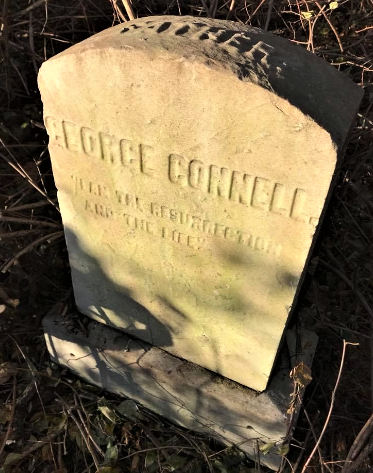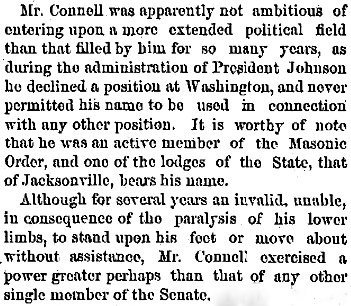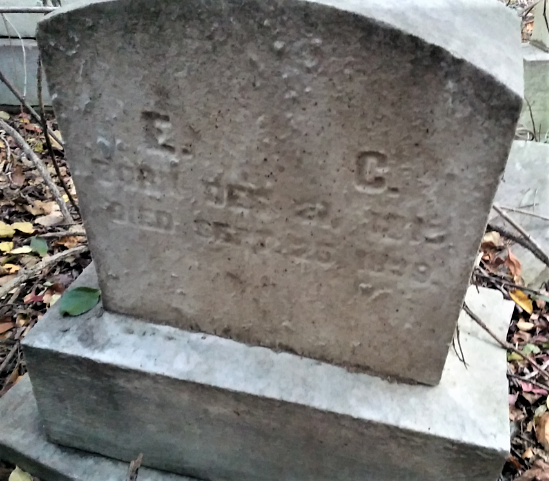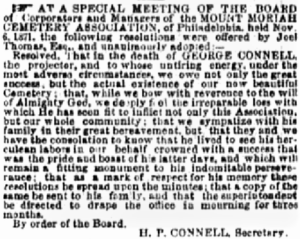Title: Co-founder of Mount Moriah Cemetery; real estate developer, state senator
Birthdate: October 4, 1815
Death Date: October 26, 1871
Plot Location: Section 33, Lot 19

Each of the officials of Mount Moriah Cemetery Association (the organization that founded Mount Moriah and ran the cemetery until it closed) led noteworthy lives, and through their individual life stories the history of this hallowed ground is revealed. Follow the links provided to see how each life story connects with the others, and learn more about the unique place entrusted to their care.
Two of the original owners of Mount Moriah were not only astute in business but successful in real estate and proficient in law and politics. They were both Masons and both came from a Quaker background, although the cemetery they founded was non-sectarian. One of them was George Connell, whose family remained involved in the business for generations. This is not only his life story but the story of the cemetery he created.
Earl Life & Marriage
George was born in Ryerson Station, Greene County, in the southwest corner of Pennsylvania. He and his sister were the only children of Joseph Richards Connell and his wife, Hannah Matilda Pennock. They were both originally from the southeast corner, in Delaware and Chester Counties, respectively. A story passed down by his descendants was that Joseph presided over the first town meeting in Philadelphia, held sometime before 1810. He advocated war with England, which became known as the War of 1812.
George graduated from Madison College, a Methodist Episcopal school in Uniontown, south of Pittsburgh. In 1837 he married Elizabeth Pennock in Philadelphia, whose father, Horatio Pennock, was the brother of George’s mother. That means George and Elizabeth were first cousins. He was a merchant in Pittsburgh for seven years while Elizabeth gave birth to six children. The first two were twins but only one survived.
They moved to Philadelphia in 1843 where Elizabeth had seven more children. St. James Kingsessing was the name of their church, which had Lutheran roots. Still thriving today as an Episcopal congregation, most of the Connell children and grandchildren were baptized there at 68th and Woodland Ave. Over the next 16 years George did very well as a real estate developer and built several hundred homes. He also began studying law at the offices of Henry Wallace, the publisher of a weekly law journal called The Legal Intelligencer.
Cemetery Development
In 1853 he pooled his funds with Henry to buy 155 acres in southwest Philadelphia County for $68,000 at a Sheriff’s sale. They determined the most profitable use of the land would be as a cemetery, so the “Mount Moriah Cemetery Association of Philadelphia” was created, with George as Secretary. Henry was on a smaller board of “Incorporators” who only met as needed and to receive the Annual Report from the Board of Managers. They made a deal with William B. Johns, the owner of an adjacent 54-acre farm, where he would receive funds from the first sale of lots until he received his price for the land.
The ’s first president of the Board of Managers was the owner of King & Baird Publishing Company, one of the printers of The Legal Intelligencer. His name was Robert Pennock King, which means he was also a relative of the Connells. (Robert is also buried at Mount Moriah and his Notable life story is found here.)
The articles of incorporation weren’t approved by the state legislature until March of 1855 but maps were drawn and lots were numbered in the first few sections as early as June of 1854. That’s when newspaper advertising began, promoting the advantages of the park-like setting.
The “rural cemetery” was the current trend, moving away from small burial grounds in churchyards that catered only to their own flock. They featured more open space that afforded an environmental “oasis,” yet within a short distance of urban areas. They even became a popular destination for picnicking on Sunday afternoons.
Land was prepared for the first burial, or at least the first to be advertised in the newspapers. It was on May 15, 1855 for a 26-year-old printer named Robert McCloy. Where that plot was located has not yet been discovered.
By the next board meeting on June 7, 16 additional burials had been made. A Masonic lodge and St. Paul’s Episcopal Church had committed to purchase certain lots. The grounds took on a special reverence for George just ten months later. He had to bury one of his daughters there who was just six years old.
Years later, newspaper reports indicated Henry bought out his partners, but George managed the operation. Somehow the deed for the 54 acres was conveyed to George individually. Another purchase of land was made by the cemetery but deeded to George’s wife and son, then a third land deal for the Delaware County tract was made by Henry and George.
Politics & Later Years
George was elected to the State Senate in 1859 and again in 1863, 1867, and 1871, just two weeks before his death in October. He also became chairman of the Senate Finance Committee and was  generally praised for his work, as shown in this part of his obituary. He is remembered for pushing legislation to create Fairmount Park and to authorize construction of a new City Hall.
generally praised for his work, as shown in this part of his obituary. He is remembered for pushing legislation to create Fairmount Park and to authorize construction of a new City Hall.
Meanwhile, he remained in charge of cemetery operations, along with his wife and son, Horatio Pennock Connell. Three other children of George and Elizabeth were buried there in the 1860s.
None of the family members had elaborate monuments, even George, who died in 1871 from chronic kidney disease. His plain stone has the word “Father” on the rim, and after his name are the words of Jesus, “I am the resurrection and the life.” His birth and death dates are on the other side under his initials, G.C.
An 1872 map shows Elizabeth had title to a tract of roughly 20 acres on Kingsessing Ave east of the cemetery. She lived until 1899 as head of her household on that  property. Listed with her on the 1880 census were four adult children and two servants. In true Connell modesty, her gravestone is only inscribed with her initials, followed by her birth and death dates.
property. Listed with her on the 1880 census were four adult children and two servants. In true Connell modesty, her gravestone is only inscribed with her initials, followed by her birth and death dates.
George was recognized posthumously for his contributions to Philadelphia and his service as a State Senator. In 1910 the city designated a block of land bounded by 64th St., Elmwood Ave., 65th St., and Grays Ave. as George Connell Park.
Before he died, George told Henry that the cemetery was never profitable so that’s why he never saw any return on his investment. A few years later Henry began to question that, filing suit in 1877 to demand half-ownership. Elizabeth and Horatio claimed the deeds were in their names. A settlement was reached out of court just a month before Henry died, in February of 1879. Read more on his Notable life story here.
Henry gained nothing financially except for greater transparency in business transactions. Among other concessions, the Association would hold title to unsold land in Delaware County, 10 percent of sales there would be go to pay off a mortgage on that land, and 10 percent of all sales would be set aside in a perpetual maintenance fund.
When George died the Board of Managers placed this notice in the newspapers in tribute. It shows that Horatio was the board secretary, a position he held for the rest of his life. He also pursued a political career while keeping control of Mount Moriah. Follow the cemetery’s story through the life story of Horatio Pennock Connell here.
placed this notice in the newspapers in tribute. It shows that Horatio was the board secretary, a position he held for the rest of his life. He also pursued a political career while keeping control of Mount Moriah. Follow the cemetery’s story through the life story of Horatio Pennock Connell here.

Support the Friends of Mount Moriah
Help us in our mission to restore and maintain the beautiful Mount Moriah Cemetery by donating to our cause or volunteering at one of our clean-up events.

